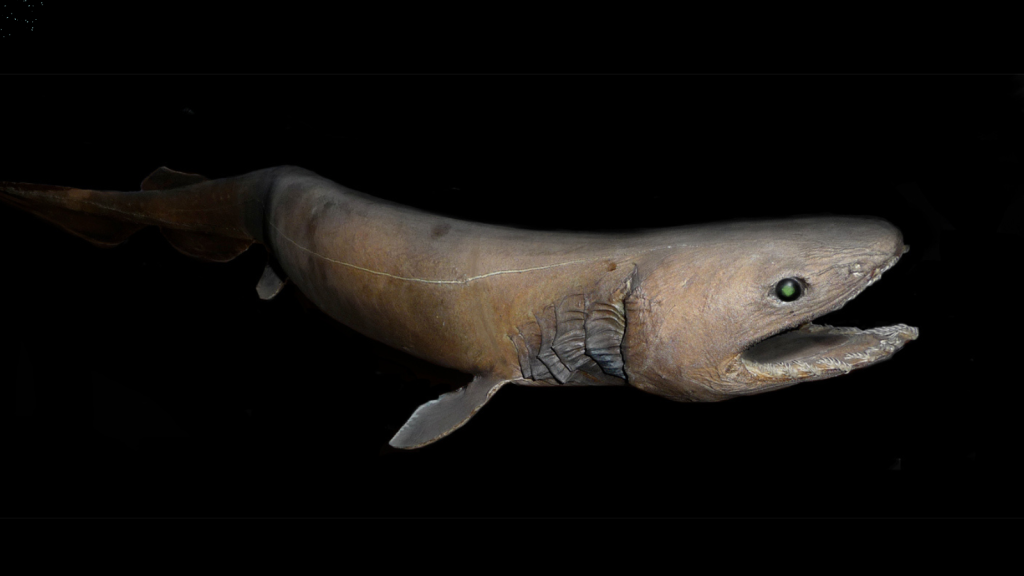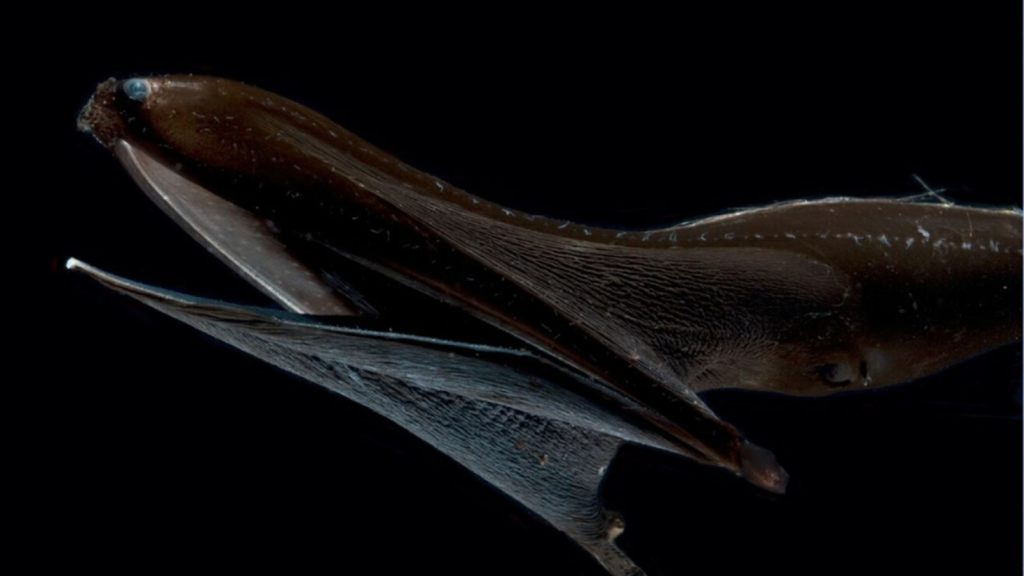The ocean’s twilight zone, a murky realm between 200 and 1,000 metres deep, is home to some of the most bizarre creatures on Earth. This shadowy world, barely touched by sunlight, harbours a menagerie of alien-like beings that seem to have sprung from the pages of a science fiction novel. From fish with see-through heads to squid that glow in the dark, these creatures have evolved extraordinary adaptations to survive in this harsh environment. Join us as we dive into the depths to explore 15 of the most nightmarish inhabitants of this mysterious underwater world.
Giant Isopod

These oversized relatives of woodlice can grow up to 76 centimetres long. With their armoured exoskeletons and multiple pairs of legs, giant isopods look like something from a prehistoric era. They’re scavengers, feeding on the remains of animals that sink to the ocean floor. Giant isopods can go for years without eating, slowing their metabolism to survive long periods between meals.
Fangtooth

True to its name, the fangtooth fish sports a mouthful of enormous, fang-like teeth. These fearsome choppers are so big that the fish can’t fully close its mouth. Despite its terrifying appearance, the fangtooth is relatively small, typically growing to about 16 centimetres in length. Its teeth are the largest in proportion to body size of any fish in the ocean.
Vampire Squid

Don’t let the name fool you – this cephalopod doesn’t suck blood. The vampire squid gets its moniker from its dark colour and the web of skin between its arms, which resembles a cape. When threatened, it can turn itself inside out, revealing rows of sharp spines. It’s also bioluminescent, capable of producing flashes of light from organs called photophores on its body.
Barreleye Fish

Also known as the spook fish, the barreleye has a transparent head filled with fluid. Its tubular, upward-facing eyes can rotate within this see-through dome, allowing it to spot prey swimming above. This bizarre adaptation helps it survive in the dimly lit waters of the twilight zone. The barreleye’s eyes are extremely sensitive to light, enabling it to detect even the faintest bioluminescent flashes.
Frilled Shark

This living fossil has changed little in 80 million years. With its elongated, eel-like body and rows of needle-sharp teeth, the frilled shark is a fearsome predator. It gets its name from the frilly appearance of its six pairs of gill slits. The frilled shark’s flexible jaw allows it to swallow prey up to half its own size whole.
Goblin Shark

With its protruding snout and nail-like teeth, the goblin shark looks like a creature from a nightmare. Its jaws can extend outwards to snatch prey, much like the monster in the “Alien” films. This rare species is sometimes called a “living fossil” due to its primitive features. The goblin shark’s snout is packed with sensory organs that help it detect electrical signals from potential prey in the darkness.
Black Swallower

This small fish has an enormous stomach that allows it to swallow prey up to ten times its own size. The black swallower’s elastic belly can stretch to accommodate its oversized meals. Sometimes, it bites off more than it can chew, quite literally, leading to its own demise. Scientists have found dead black swallowers floating on the ocean surface with partially digested fish in their stomachs larger than themselves.
Viperfish

With its needle-like teeth and bioluminescent lure, the viperfish is a fearsome predator of the deep. Its first dorsal fin spine has been modified into a light-producing organ that it uses to attract prey. Some of its teeth are so long that they curve back towards its eyes when its mouth is closed. The viperfish can unhinge its jaw and rotate its head upwards to swallow large prey whole.
Giant Squid

Long the stuff of sailors’ legends, the giant squid can grow up to 13 metres long. Its eyes, the largest in the animal kingdom, can be as big as dinner plates. These elusive creatures were first captured on film in their natural habitat only in 2004. Giant squids have three hearts and blue blood, which is more efficient for transporting oxygen in cold, deep waters.
Anglerfish

Female anglerfish have a bioluminescent lure growing from their heads, which they use to attract prey in the darkness. The males, much smaller than females, latch onto their mates and eventually fuse with them, losing their eyes and internal organs in the process. This extreme sexual dimorphism ensures that when a female finds a mate in the vast ocean, she always has a supply of sperm for reproduction.
Gulper Eel

Also known as the pelican eel, this bizarre creature has a mouth that’s larger than its body. Its huge jaws allow it to swallow prey much larger than itself. When not feeding, its mouth folds away like a deflated balloon. The gulper eel’s tail is tipped with a light-producing organ that may be used to attract prey or mates.
Chimaera

Often called ghost sharks, chimaeras are cartilaginous fish related to sharks and rays. They have a venomous spine in front of their dorsal fin and grinding plates instead of teeth. Their eerie, ghost-like appearance has earned them their spooky nickname. Male chimaeras have retractable sex organs on their foreheads, which they use to grip females during mating.
Stoplight Loosejaw

This small predatory fish has a lower jaw that’s unattached at the back, allowing it to open its mouth extremely wide. It produces red light from organs near its eyes – a colour that most deep-sea creatures can’t see, giving it a secret form of illumination to spot prey. The stoplight loosejaw is one of the only animals known to produce red bioluminescence, which it uses like a sniper’s night-vision goggles.
Giant Tube Worms

These bizarre creatures can grow up to 2.4 metres long and lack a mouth, eyes, or gut. Instead, they survive by housing bacteria in their bodies that convert chemicals from hydrothermal vents into energy. They were only discovered in 1977 and have revolutionised our understanding of life in extreme environments. Giant tube worms can grow up to 1.5 metres per year, making them some of the fastest-growing marine invertebrates.
Coffinfish

This bottom-dwelling relative of the anglerfish gets its name from its box-like shape. It has a lure on its snout to attract prey and can inflate its body with water when threatened, making itself harder for predators to swallow. The coffinfish’s lure, unlike that of its anglerfish cousins, produces a bioluminescent mucus that it can squirt at potential prey or predators.
15 Facts About the Honey Badger, the Fiercest Animal in Africa

The honey badger, a small but mighty creature, roams the African wilderness with a fearless attitude that’s earned it quite a reputation. These tenacious animals have captured the imagination of wildlife enthusiasts and casual observers alike. Despite their name, honey badgers aren’t closely related to European badgers and are more akin to weasels and otters. Their tough-as-nails approach to life and remarkable abilities have made them the stuff of legend. Let’s explore some fascinating facts about these extraordinary creatures that prove why they’re considered Africa’s fiercest animals.
Read More: 15 Facts About the Honey Badger, the Fiercest Animal in Africa
Becky is a fervent wildlife enthusiast and pet care expert with a diploma in canine nutrition. Her love for animals stretches beyond the domestic, embracing the wild tapestry of global fauna. With over a decade of experience in animal welfare, Becky lends her expertise to OutlandishOwl through insightful articles, captivating wildlife information, and invaluable guidance on pet nutrition. Her work embodies a deep commitment to understanding the intricate lives of animals and a passion for educating others on sustaining natural habitats. Becky's hands-on conservation efforts and her knack for translating complex dietary science into practical pet feeding tips make her an indispensable voice for creatures great and small.




